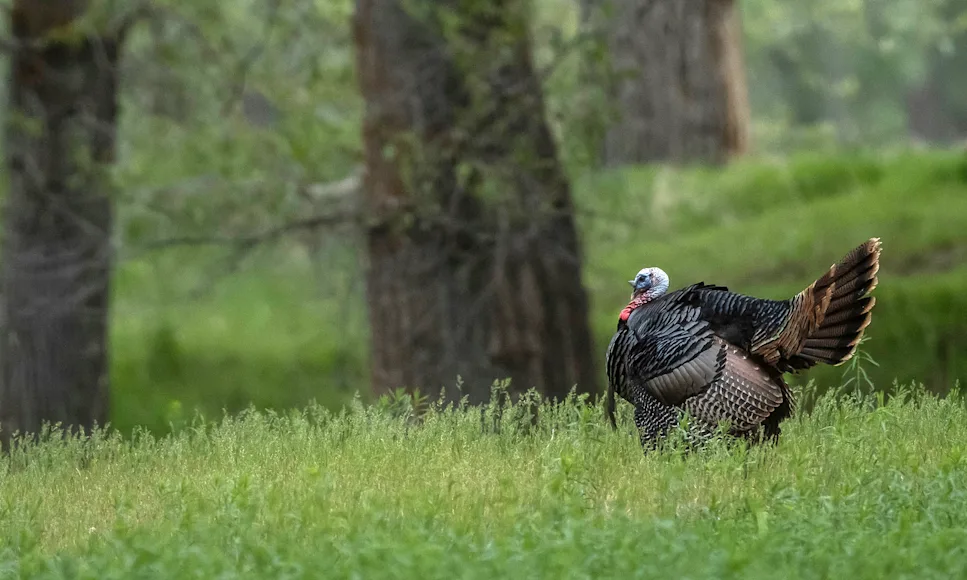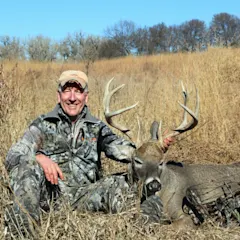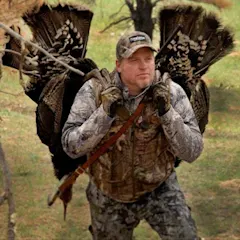For spring gobbler hunters, the late season is a bit of a double-whammy. First off, a fair number of the toms that were gobbling their heads off and running to decoys in the early season are in hunter's freezers (or bellies) by now. Second, what gobblers are left on the landscape have likely been bumped a time or two, have heard a lot of artificial yawping, and have possibly been shot at. Bottom line: They are at their absolute wariest.
But why should any of that stop you if you've still got a tag in your pocket? You can still get it done, according to our experts, and the odds of flopping a whopper tom may even be better now. Here are their top tips, plus a few of our own, for dealing with late-season birds in general, and for putting a tag on even the most pressured public-land toms.
1. Find the short grass, where turkeys can strut.

“Late-season gobblers actually avoid many of the places where they liked to strut in the early season,” says Tim Herald, turkey nut and owner of Worldwide Trophy Adventures. “Fields and openings are now grown up to tall grass, weeds, or crops, which makes gobblers less visible to hens and more susceptible to predators.” Herald says that toms stay away from these areas on dewy mornings especially, when walking through tall vegetation will get them soaked. “Late in the season, I start looking for short-grass pastures grazed by cattle, or I’ll go out and mow a known strutting area to keep it attractive to gobblers.”
Related: Best Turkey Shoguns of 2025
2. Hunt tough turkeys like you hunt deer.
“We have plenty of pressure in my area, and by the time the season has been on awhile, many gobblers have been bumped several times or shot at,” says Grand National calling champ and Georgia native Ricky Joe Bishop. “Often those turkeys will gobble but not come to a call.” That’s when Bishop goes into deer hunting mode and puts in the time to pattern tough gobblers. “I’ll listen, observe, and use trail cameras to figure out where a bird feeds or struts after fly-down. Then I figure out where he might be vulnerable, like a logging road cutting through the timber or a field edge, and I set up there. I might not call at all. I’ll just tuck in and wait for him to do what he wants to do.”
3. Hunt midmorning for public-land toms.
The funny thing about this tip, says Hunters Specialties pro Tad Brown is that everyone knows it, and yet very few actually do it. “It’s still the rare hunter who’s in the timber after 9 a.m.,” he says. “I’ll never forget this one hunt on a pressured public wildlife area with my brother-in-law. We drove in there at 9:30 and met six vehicles coming out. A couple of the hunters told us they hadn’t heard a gobble in hours. We struck three different gobblers and killed one at noon. I’ve seen that scenario play out so many times it’s ridiculous. I think one of the keys to hunting pressured turkeys is to do things differently than other guys, and one of the easiest way to do that is to hunt midmorning, or later in the day if your state allows it.”
4. Target the boss gobbler.

“It’s pretty common for the most dominant gobbler to also be the toughest bird to tag during much of the season,” says Brown. “Hunters think he’s smart because he doesn’t respond to calling, but if he’s an old, big bird, he’s just used to gobbling and having hens to come to him.” But that bird is in a different world now, as most hens are nesting and not coming to him anymore, he points out. “This is my favorite time to target a big turkey that’s been difficult all spring, as he’ll suddenly start behaving like a 2-year old.”
5. Don’t be in a rush with late turkeys.
Moving to get tight to a turkey is usually a good idea, but the late season is one of the easiest times to misjudge the distance to a gobble. With foliage on trees and brush growing fuller by the day, the sounds of even a roaring gobble can get sucked up by the dense vegetation and make the bird sound much farther away than he actually is. When you strike a turkey in mid- to late May, your first move should be to sit your butt down and take some extra time to really pinpoint that bird before moving in. This also holds true for roosting now; when a gobbler is up high in the canopy of an oak grove, he may sound a mile away when he’s more like 200 yards. Be careful, and move in slow.
6. Make a milk run of known strut zones.

Kentucky turkey expert and outdoor writer Travis Faulkner spends much of his spring chasing mountain gobblers on public land, and he uses many of the same tactics on big-woods gobblers that he employs on whitetail bucks. “My scouting and trail-cam use has shown that gobblers have a series of strut zones that they visit throughout the day,” he says. “And my trail cams, which I set on video mode, prove that a tom might stay in that zone for up to an hour and never gobble.” If Faulkner can’t get a gobbler to sounds off to a call, he’ll just head to a strut zone. “I’ll set up for a while and call, and if I get no response and I don’t feel like staying, I move to the next one. I know gobblers make these milk runs almost every day, and I just copy their behavior.”
7. Tone down your turkey calling.
World champion caller and Woodhaven Game Calls call maker Billy Yargus can make a turkey call do just about anything he wants, but he takes his foot off the gas when dealing with pressured gobblers late in the season. “I think the key is to match what the turkeys are doing,” he says. “Late season turkeys might be yapping it up pretty good on a certain farm or a particular day, so I’m not afraid to call aggressively then. But for the most part, I’m relying on a lot of clucking, purring, and soft yelping. I don’t believe turkeys get call shy, per se, but they start to associate lots of noise—gobbling, hard yelping, and cutting—with a hunter showing up; it’s the same thing that happens when there are lots of coyotes or other predators around. So, I’m just prepared to rely on my knowledge of where birds like to be, then use soft calling to coax them in.”
Related: Strut Reporters: Best Times to Hunt Turkeys All Season
8. Go the distance to find unpressured birds.
Jeff Budz, who has taken more well over 100 turkey grand slams and owns Tag It Worldwide, has killed many of his gobblers on public land, and one of the features he looks for on any tract is difficult access. “I don’t care if I have to wade a swamp, paddle across a river, or hike a mountain; I’m not afraid to make the physical effort to get away from other hunters,” he says. “Sometimes it doesn’t even have to be a really intimidating obstacle to lose the competition. But I know I’m willing to work harder than most guys, because I’ve seen the reward—gobblers that have rarely, if ever, been worked by another hunter.”
Tad Brown agrees. “If there’s a logging road that stretches a mile and only gets foot traffic, that second half-mile is probably hosting turkeys that have never been bumped by a hunter,” he says.
9. Get tight to late-season turkeys.
“One common trait of toms that have seen some pressure is a willingness to gobble but a hesitation to walk far to a call,” says Tim Herald. “While it’s usually advisable to get as close to a turkey as possible before calling to him, it’s critical in late season, after birds have been bumped and the breeding peak is past.” The good news is that the heavier foliage of the late season makes that much easier to pull off. “I like to be within 75 to 100 yards, max, of a gobbler before I even touch a call now. If a bird is roosted, you have that fuller canopy and darker shadows to make getting tight possible. If I strike a bird at midday and I don’t know his exact location, I’ll use locator calls to pinpoint him before slipping in and calling.”
10. Stake out a turkey dusting area.

As hens start nesting, dusting areas become hotspots that many hunters overlook, according to Travis Faulkner. “Hens become really faithful to their dusting areas this time of the season, and gobblers will often show up at these sites and hope for an encounter.” Setting up on a dusting area is another excellent tactic on days when the gobbling is poor to non-existent. “I don’t hesitate to call from these spots,” says Faulkner. "A gobbler will hear that yelping and think Oh, she’s there again, and waltz in.”
11. Buddy up on a roosted tom.
Many late-season gobblers, especially old ones, have the maddening habit of flying away from calling as they exit the roost. “While it’s tempting to believe they’re nervous that the calling they hear is a hunter, what’s probably happening is that they’re simply used to having hens come to them, and so they just fly to a strut zone where they know that’s going to happen,” says Billy Yargus. “Lots of times a tom will have more than one strut zone, and one of the best ways to kill that turkey is to bring a buddy. Each hunter sets up in a different zone, and from there you just decide if you want to call or not. In my experience, the tom is probably going to land near the guy who never touches a call. But the minute you bank on that, the bird will do just the opposite.” Either way, one of you fills a tag.
12. Hunt the secondary turkey “rut.”

“Whitetail hunters know all about the secondary rut, which typically involves yearling does entering their first estrous cycle,” says Travis Faulkner. “Well the same thing happens with jennies, last year’s hen poults that are now ready to breed.” Often, these young hens aren’t ready to breed until long after the mature hens, so you can actually get a second breeding peak. “To imitate a jenny, I use a call without the rasp and harsh roll-over of an old boss hen. A yelp that ends on a clear, high note imitates a jenny almost perfectly. In my experience, a wingbone yelper is the perfect call to imitate this.”
13. Pick a fight with a late-season gobbler.
In states where the season goes on long enough, gobblers will actually start to group up again, just like bucks do after the rut, says Tim Herald. “When they’re coming back together, they’ll start to fight a good bit, so when I have a bird that gobbles but won’t come, I’ll gobbler yelp, gobble, or run fighting purrs. That makes him think there’s a tom or two hanging around the hen he just heard. It can be a really good way to make a late-season gobbler who’s dragging his feet suddenly break and come.”
14. Use a locator call to bushwhack a bird.

We’ve all run into those pressured late-season toms that won’t answer a hen call, let alone come to one, and yet they’ll climb all over a locator call, even at midmorning, whether it’s a crow call, owl hooter, or gobble tube (where it’s safe to use one). These birds often travel in pairs or groups, and one way to tag them—sometimes the only way—is to keep them gobbling with the locator, then figure out their line of travel and get in front of them. Once you’re where they want to be, it’s a lot easier to pull these toms in with realistic decoys or subtle calling. Or simply study the terrain and bushwhack them along a ridge spine or other terrain funnel, without ever making a call. It’s not the most exciting way to take a gobbler, but it beats tag soup.
15. Hunt a turkey-roost staging area.
States that allow all-day hunting offer the opportunity of setting up on staging areas that gobblers use before flying up to roost, says Faulkner. “Go to a common roosting site and look for feathers, droppings, scratchings, and even strut marks. Gobblers typically get to their roosting area long before fly-up, and they’ll spend some time there, often gobbling and strutting before flying up for the night. These are excellent areas to set up on for an evening hunt. Even if you don’t kill the gobbler, you’ll probably have his roost pin-pointed for the morning hunt.”
Related: Best Turkey Loads of 2025
16. Keep quiet for roosted gobblers.
Tom Weddle, a public land turkey hunter with 33 slams and three U.S. Super Slams under his belt, says that he’s definitely seen extra pressure in the woods since the COVID-19 pandemic. “It’s made things more challenging than normal.” To beat the crowds, Weddle suggests staying out all day where it’s legal to do so. He also thinks it’s a bad idea to call to roosted birds in the morning. “I need the tom’s feet on the ground ASAP, and calling to them only gives the ornery devils an excuse to stay tree-bound and gobbling to attract hens,” he says. That gobbling is going to get the attention of other hunters, too, so when Weddle does start to call, he tries to keep it low key. “Firing up a tom might be fun, but it’s bound to bring competition.”
17. Head for the far corners.
Aaron Warbritton of The Hunting Public has also been seeing a lot of pressure in the woods in recent years. His team’s annual Turkey Tour YouTube series takes them all over the country hunting gobblers on public land in places they sometimes haven’t hunted before. “We’ve noticed that turkeys often move towards the back corners of public hunting areas, especially those that are close to private land. This helps them survive when a lot of hunters hit the woods.” A good digital map that shows private/public boundaries is invaluable for finding these out-of-the-way spots. Mark as many as you can, then spend part of a day to scouting to find a less-pressured bird.
18. Double-team a hung-up gobbler.
Gobblers can pull this trick any time, but it’s classic late-season behavior: They’ll approach your set up to a certain point, then pace back and forth, refusing to close the distance into gun range. If the bird continues to gobble as he paces (many do), it’s entirely possible to kill this turkey. If you’re hunting alone and the tom is gobbling on his own, wait until you’re sure the bird has started to move away from your position and slip in closer, little by little, until you’re in shooting range. If you’re hunting with a partner, so much the better. One hunter hangs back and keeps the bird talking, while the other creeps in closer. If you run out of cover and the turkey is still just out of range, try some leaf-scratching from your last possible setup. Often the sound of another bird scratching (and not calling) is the perfect closer that will drag a gobbler the few more steps he wasn’t willing to take just moments before.



